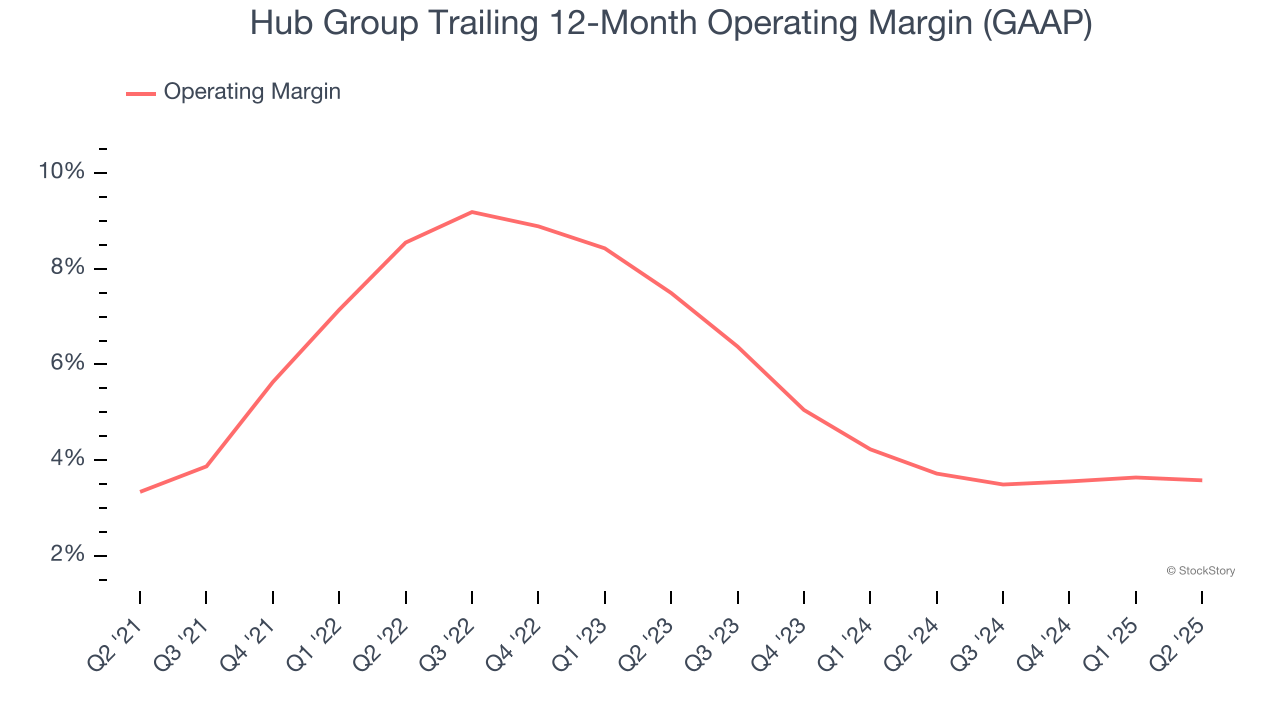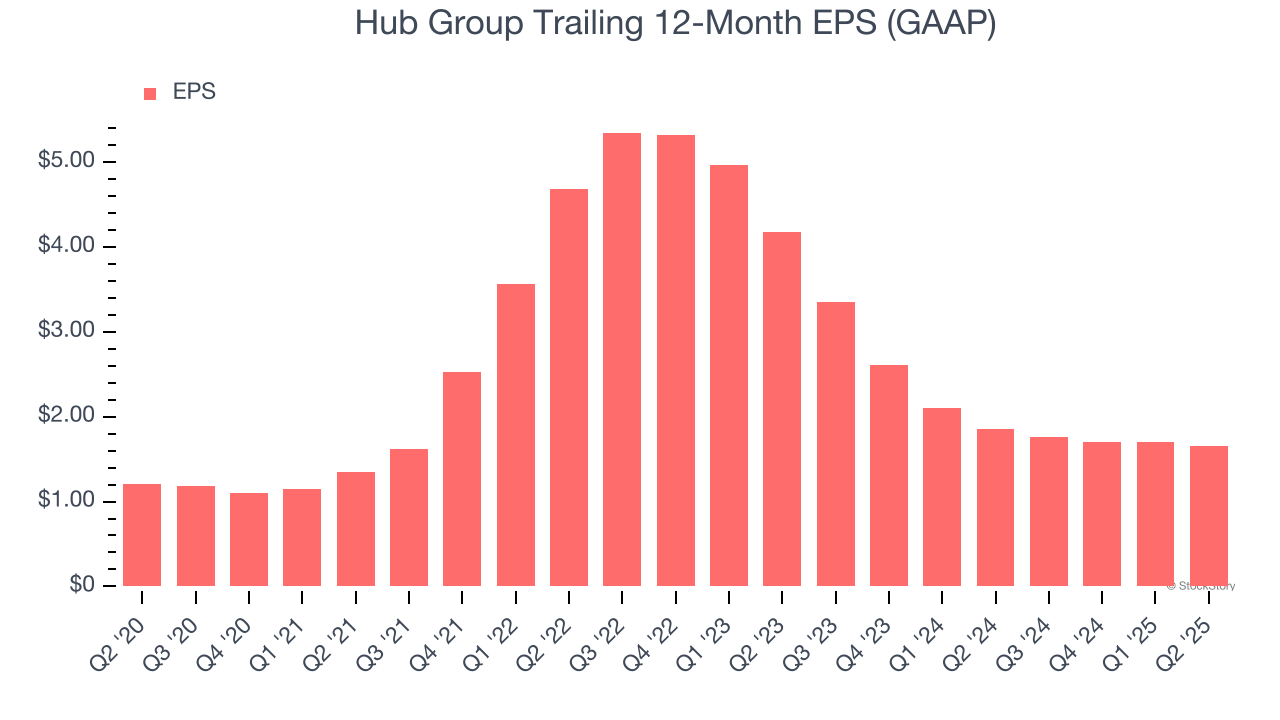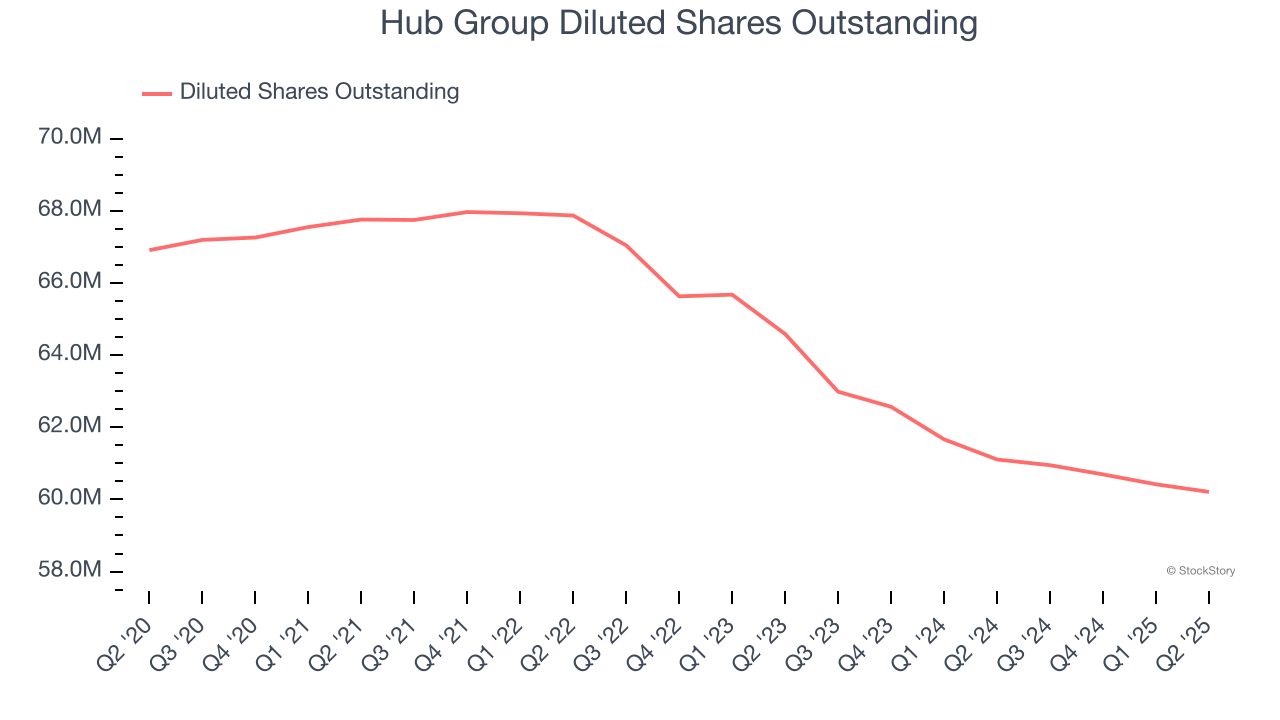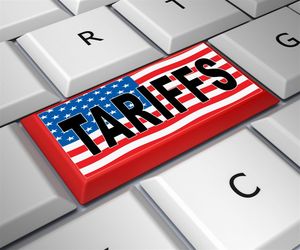
Logistics solutions provider Hub Group (NASDAQ: HUBG) fell short of the market’s revenue expectations in Q2 CY2025, with sales falling 8.2% year on year to $905.6 million. The company’s full-year revenue guidance of $3.7 billion at the midpoint came in 1.8% below analysts’ estimates. Its GAAP profit of $0.42 per share was 5.4% below analysts’ consensus estimates.
Is now the time to buy Hub Group? Find out by accessing our full research report, it’s free.
Hub Group (HUBG) Q2 CY2025 Highlights:
- Revenue: $905.6 million vs analyst estimates of $920.3 million (8.2% year-on-year decline, 1.6% miss)
- EPS (GAAP): $0.42 vs analyst expectations of $0.44 (5.4% miss)
- Adjusted EBITDA: $85.05 million vs analyst estimates of $77.26 million (9.4% margin, 10.1% beat)
- The company dropped its revenue guidance for the full year to $3.7 billion at the midpoint from $3.8 billion, a 2.6% decrease
- EPS (GAAP) guidance for the full year is $1.92 at the midpoint, beating analyst estimates by 2.4%
- Operating Margin: 3.8%, in line with the same quarter last year
- Free Cash Flow Margin: 5.1%, similar to the same quarter last year
- Market Capitalization: $2.13 billion
“The team continues to navigate this operating environment with a focus on serving customers, improving productivity, and leveraging growth investments. Intermodal margin performance and new customer wins for the Final Mile business reflect success with our approach. Hub Group has made progress with cost-saving initiatives and remains opportunistic with capital deployment as reflected in the announced agreement to acquire certain assets from Marten Intermodal. Although market conditions remain challenging, higher margin and free cash flow performance from cycle trough-to-trough highlight the benefits of our strategy and execution, and we remain optimistic on the long-term growth opportunity,” said Phil Yeager, Hub Group’s President, Chief Executive Officer and Vice Chairman.
Company Overview
Started with $10,000, Hub Group (NASDAQ: HUBG) is a provider of intermodal, truck brokerage, and logistics services, facilitating transportation solutions for businesses worldwide.
Revenue Growth
A company’s long-term sales performance is one signal of its overall quality. Any business can put up a good quarter or two, but the best consistently grow over the long haul. Regrettably, Hub Group’s sales grew at a sluggish 2% compounded annual growth rate over the last five years. This fell short of our benchmarks and is a rough starting point for our analysis.

We at StockStory place the most emphasis on long-term growth, but within industrials, a half-decade historical view may miss cycles, industry trends, or a company capitalizing on catalysts such as a new contract win or a successful product line. Hub Group’s performance shows it grew in the past but relinquished its gains over the last two years, as its revenue fell by 11.6% annually. Hub Group isn’t alone in its struggles as the Air Freight and Logistics industry experienced a cyclical downturn, with many similar businesses observing lower sales at this time. 
This quarter, Hub Group missed Wall Street’s estimates and reported a rather uninspiring 8.2% year-on-year revenue decline, generating $905.6 million of revenue.
Looking ahead, sell-side analysts expect revenue to grow 2.6% over the next 12 months. Although this projection indicates its newer products and services will fuel better top-line performance, it is still below average for the sector.
Today’s young investors won’t have read the timeless lessons in Gorilla Game: Picking Winners In High Technology because it was written more than 20 years ago when Microsoft and Apple were first establishing their supremacy. But if we apply the same principles, then enterprise software stocks leveraging their own generative AI capabilities may well be the Gorillas of the future. So, in that spirit, we are excited to present our Special Free Report on a profitable, fast-growing enterprise software stock that is already riding the automation wave and looking to catch the generative AI next.
Operating Margin
Hub Group’s operating margin might fluctuated slightly over the last 12 months but has remained more or less the same, averaging 5.6% over the last five years. This profitability was paltry for an industrials business and caused by its suboptimal cost structureand low gross margin.
Looking at the trend in its profitability, Hub Group’s operating margin might fluctuated slightly but has generally stayed the same over the last five years. This raises questions about the company’s expense base because its revenue growth should have given it leverage on its fixed costs, resulting in better economies of scale and profitability. Hub Group’s performance was poor, but we noticed this is a broad theme as many similar Air Freight and Logistics companies saw their margins fall (along with revenue, as mentioned above) because the cycle turned in the wrong direction.

This quarter, Hub Group generated an operating margin profit margin of 3.8%, in line with the same quarter last year. This indicates the company’s cost structure has recently been stable.
Earnings Per Share
Revenue trends explain a company’s historical growth, but the long-term change in earnings per share (EPS) points to the profitability of that growth – for example, a company could inflate its sales through excessive spending on advertising and promotions.
Hub Group’s EPS grew at an unimpressive 6.5% compounded annual growth rate over the last five years. On the bright side, this performance was better than its 2% annualized revenue growth and tells us the company became more profitable on a per-share basis as it expanded.

Diving into the nuances of Hub Group’s earnings can give us a better understanding of its performance. A five-year view shows that Hub Group has repurchased its stock, shrinking its share count by 10%. This tells us its EPS outperformed its revenue not because of increased operational efficiency but financial engineering, as buybacks boost per share earnings. 
Like with revenue, we analyze EPS over a more recent period because it can provide insight into an emerging theme or development for the business.
For Hub Group, its two-year annual EPS declines of 37.1% show it’s continued to underperform. These results were bad no matter how you slice the data.
In Q2, Hub Group reported EPS at $0.42, down from $0.47 in the same quarter last year. This print missed analysts’ estimates. Over the next 12 months, Wall Street expects Hub Group’s full-year EPS of $1.65 to grow 27.9%.
Key Takeaways from Hub Group’s Q2 Results
We were impressed by how significantly Hub Group blew past analysts’ EBITDA expectations this quarter. We were also glad its full-year EPS guidance exceeded Wall Street’s estimates. On the other hand, this quarter's revenue and EPS fell short. Overall, this was a mixed print. The stock remained flat at $35.02 immediately following the results.
Big picture, is Hub Group a buy here and now? What happened in the latest quarter matters, but not as much as longer-term business quality and valuation, when deciding whether to invest in this stock. We cover that in our actionable full research report which you can read here, it’s free.





